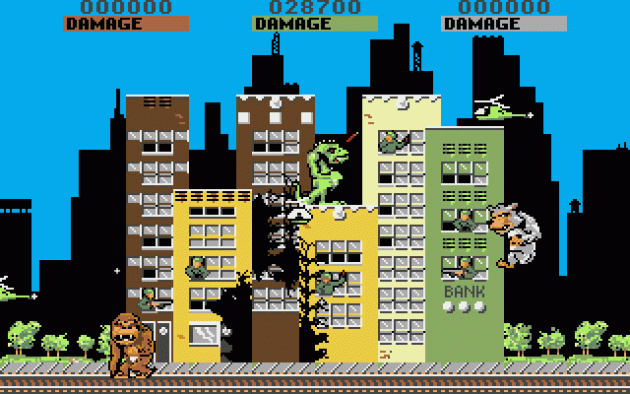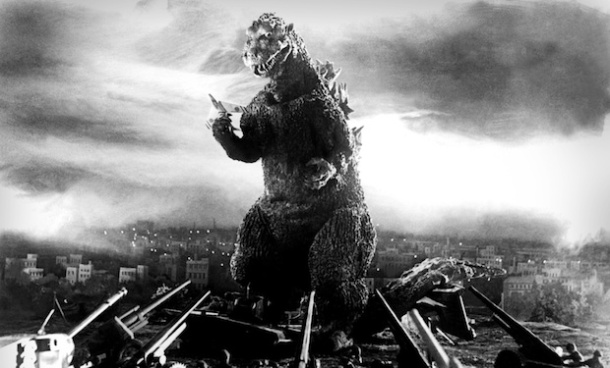April Shame: So Godzilla (1954) isn’t really a monster movie
by James David Patrick (originally posted at cinemashame.wordpress.com)
The confluence of me and Godzilla is an odd twisty tale of no matter. That said, let’s dive in and read about all of that inconsequence.
It all began back in the late 1980’s with a little arcade game called Rampage where you controlled one of three monsters as they razed buildings, ate people and destroyed all military vehicles that attempted to stop them from razing buildings or eating people. Ported over to the Nintendo Entertainment System (and pretty much every available video game system of the next decade), the monster masher became a staple in my gaming rotation. And you’re probably thinking, “But hey the lizard monster in Rampage isn’t even Godzilla – its name was Lizzie!” Or not. But either way you’d be on point. On point because you were right about the name or on point because you didn’t care either way.

Shortly after Rampage came an actual, legit Godzilla licensed NES game called Godzilla: Monster of Monsters, a side-scrolling action game featuring both Godzilla and Mothra as playable characters against the legions of classic Toho and Godzilla monsters like Gigan, Mechagodzilla, Ghidorah, etc. And it was actually pretty excellent and by excellent I mean don’t challenge my nostalgia, bro. By this point in adolescence, I was aware of the Godzilla movie franchise and knew that these were characters from the old Japanese films. When I decided it was time to watch some of these movies, I couldn’t settle merely one monster. Why would I want to watch a movie about just Godzilla when I could have Godzilla and Hedorah, the smog monster? Or Godzilla and Gezora, a massive cuttlefish?!? Clearly two monsters was better than one! Obviously! Without a doubt! And thus I watched whatever Godzilla vs. movies I could find.

I had just never watched the original Godzilla… until now…
As I started to say in the title of this ramble before the actual words got in the way, Godzilla isn’t really a monster movie at all. Okay, sure, there’s a giant rampaging radioactive lizard, but if you want a monster movie by today’s standards you’re best queuing up Alien or Q: The Winged Serpent. People are terrorized, directly, by a real goddamn monster. Godzilla, like Stay Puft, is just a sailor, in town for the weekend and all he needs is to get laid. But that’s an alternate theory to be tackled in a longer-format essay.
While watching Godzilla the specter of World War II is inescapable. Godzilla is a war film, only not as we’ve seen before – a movie about the nuclear fallout. The ever-present fear that war can no longer be confined between a first volley and a few signatures on a peace treaty. What the United States had unleashed on Japan on August 6th, 1945 wasn’t a confined act of war, but an uncontrollable monster. (Another related theory: bombs = dragon sperm, Japan = the fertile womb. I’m still working it out.) Curiously enough, I sensed no acute blame on the United States (despite the film being re-edited with Raymond Burr for stateside consumption). The atomic age, the film seems to suggest, wasn’t the fault of one man or one nation, but a sin committed by all humankind.
To punctuate the fear and persistent paranoia, director Ishiro Honda and DP Masao Tamai create a noir-like cinematic playground. Black & white stock. Contrast jacked off the charts, the blacks several shades darker than a standard contemporary palettes. This, of course, serves aesthetic and the emotional response to pending attacks, but it also allows the film’s model work and monster effects to remain in shadow as most of Godzilla’s attacks take place at night.
The result of all this is a film about a national existential and personal crisis. It’s man vs. nature, man vs. man, and man vs. the gods. It makes perfect sense, therefore, that no single individual becomes a focus of the film. The collective remains the focus, Godzilla the lead actor with a few humans standing out as representatives of science, love, religion and war. Scientists want to save or preserve the creature to study the effects of the radiation. Religious groups worship Godzilla as a deity sent to destroy man for those aforementioned sins. The government wants the creature destroyed at any cost.
All of these conflicts bubble just above the surface of the film with skilled subtlety, but that nuance doesn’t matter one bit when the viewer first catches sight of that now legendary monster. While the latter Toho Godzilla movies emphasize spectacle and superficial entertainment, the original 1954 Godzilla, despite being about a 50-meter tall lizard, emphasizes humanity through the interplay of fear, faith and foolish bravado.
In my opinion, the religious zealots got something right. Godzilla is definitely worthy of your worship.


